Macquarie University NSW 2109
Tackling big questions in astrophysics and technology
By bringing together astronomy researchers, instrumentation experts and data specialists, our centre works across discipline boundaries, creating a collaborative ecosystem for research and discovery driven by astronomy.
We are one of the largest and fastest-growing astronomical centres of research excellence in Australia, committed to investing in the next generation of researchers.
Our research spans a broad range of astrophysics, instrumentation, technology development and data-intensive capabilities, creating a unique environment for cross-disciplinary research.
Our centre comprises over 50 staff, postdocs and students, with research projects spanning a broad range of theoretical, observational, and computational astrophysics, as well as developing new instrumentation technologies and data-intensive astronomy techniques.
Learn more about our research themes and the projects currently active under them.
Extragalactic astronomy
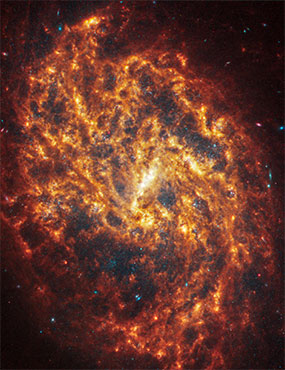 Extragalactic astronomy is the study of the Universe at distances beyond the limits of our Milky Way and its closest neighbours.
Extragalactic astronomy is the study of the Universe at distances beyond the limits of our Milky Way and its closest neighbours.
This includes the study of individual distant galaxies, to using those galaxies to trace the very structure and evolution of the Universe.
- The impact of environment on galaxies as probed by the SAMI and Hector Galaxy Surveys
- Understanding galaxies near and far with MUSE
- Measuring galaxy star formation rates
- From dust formation to star formation in galaxies
- Unveiling the connections between gas, stars and star formation in nearby dwarf galaxies
- Searching for faint absorbing galaxies in emission
Stellar and planetary astrophysics
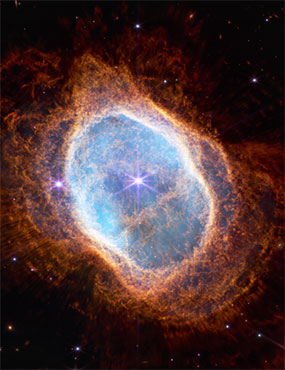 This theme includes:
This theme includes:
- stellar structure and evolution, particularly in low and intermediate mass stars, binary interactions (see also theoretical and computation astrophysics)
- chemical evolution and origin of the elements
- clusters and populations (see also Milky Way and Local Group)
- galactic archaeology and galactic formation
- planet formation (see also theoretical and computation astrophysics)
- exoplanets detection (see also instrumentation and space technologies).
- Star clusters as probes of stellar evolution and nucleosynthesis
- Using dying stars to reveal the origin of elemental isotopes in the Universe
Milky Way and Local Group
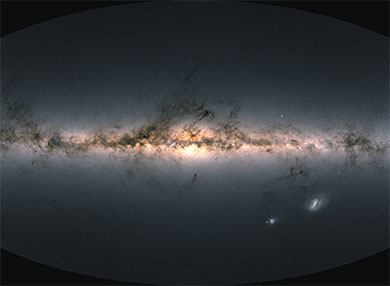 Our location in the Milky Way provides us with a unique vantage point to study the structure, composition and kinematics of our home galaxy, the Andromeda galaxy and other galaxies in our Local Group.
Our location in the Milky Way provides us with a unique vantage point to study the structure, composition and kinematics of our home galaxy, the Andromeda galaxy and other galaxies in our Local Group.
Astronomers at Macquarie University use imaging, spectroscopy and radio observations to understand the nature of our local environment.
Image by: BY-SA 3.0 IGO, A. Moitinho
- Using open clusters to probe the Galaxy
- Spectroscopy and the composition of stars in globular clusters
- Stellar variability: Redefining the Milky Way's fundamentals
- Galactic archaeology
- Satellites and stellar streams in the Local Group
Interstellar medium
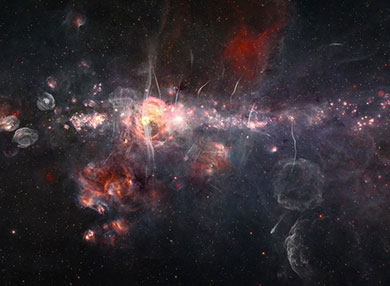 The interstellar medium (ISM) is the gas and dust between stars – the raw material from which stars form and to which they return when they die. The ISM responds to the energy and mass output by stars, in a complex feedback loop that shapes the lives of galaxies over cosmic time.
The interstellar medium (ISM) is the gas and dust between stars – the raw material from which stars form and to which they return when they die. The ISM responds to the energy and mass output by stars, in a complex feedback loop that shapes the lives of galaxies over cosmic time.
Image by: Judy Schmidt, Galactic Centre Infrared+Radio
- Revealing dust properties in distant environments
- Mapping 'dark' molecular gas with SPLASH
- The Australia Square Kilometre Array Pathfinder as a hydroxyl absorption machine
- Huntsman Probes the Cosmic Web – characterising the foreground galactic circus
Theoretical and computational astrophysics
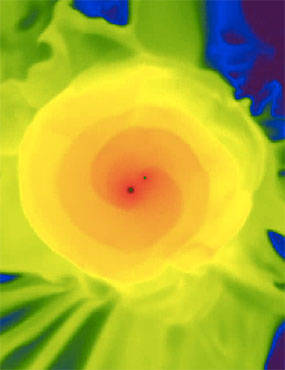 Theoretical and computational astrophysics research aims to generate models that can be tested with observations. Our group works on:
Theoretical and computational astrophysics research aims to generate models that can be tested with observations. Our group works on:
- models of stellar and binary star evolution
- planet formation
- galactic centre magnetic fields
- black holes.
The methodologies are analytical or semi-analytical models and 3D hydrodynamic simulations.
- The structure and evolution of disks around evolved binary stars and its implications on binary evolution
- Stellar collisions
Instrumentation and space technologies
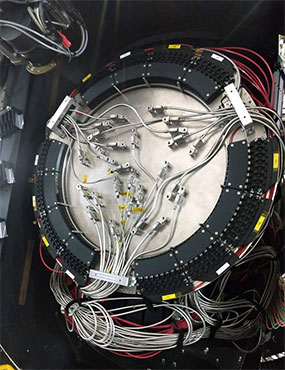 Our centre includes researchers at Australian Astronomical Optics – a recognised world leader in innovative scientific instrumentation, software and research, and a major node of the nationally funded Astralis Instrumentation Consortium.
Our centre includes researchers at Australian Astronomical Optics – a recognised world leader in innovative scientific instrumentation, software and research, and a major node of the nationally funded Astralis Instrumentation Consortium.
Our researchers engage with major ground-based observatories, to deliver innovative instruments based on new technologies we are developing. These include:
- Novel spacecraft optical systems
- Astrophotonics
- Multi-object adaptive optics
- The Huntsman Telescope: Ultra-faint galactic structures, subsecond transient searches, event cameras and daytime observing
- Adapting the Huntsman Telescope for laser communications
- An ultra-stable infrared spectrograph to search for Earth-like planets
Data science/data intensive astronomy
 Our centre includes the Research Data Services group – part of Australian Astronomical Optics (AAO).
Our centre includes the Research Data Services group – part of Australian Astronomical Optics (AAO).
It specialises in creating applications to access diverse research data sets across multiple disciplines, and developing comprehensive data processing platforms for the complex instrument suites of major astronomical observatories.
- Galaxy classification by Deep Learning